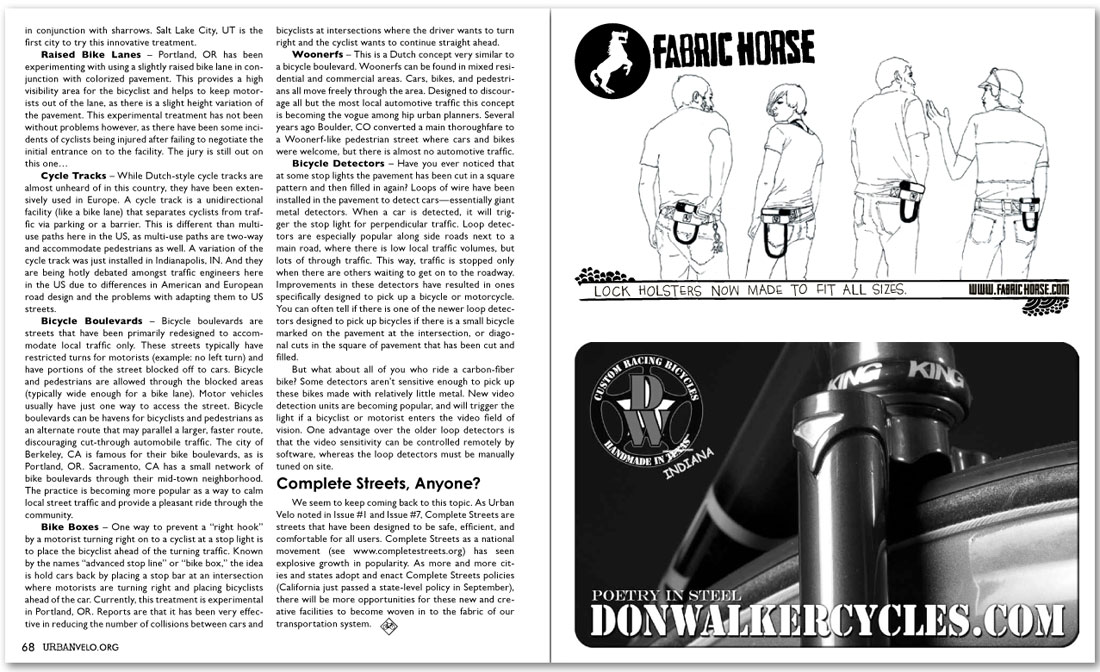in conjunction with sharrows. Salt Lake City, UT is the first city to try this innovative treatment.
Raised Bike Lanes – Portland, OR has been experimenting with using a slightly raised bike lane in conjunction with colorized pavement. This provides a high visibility area for the bicyclist and helps to keep motorists out of the lane, as there is a slight height variation of the pavement. This experimental treatment has not been without problems however, as there have been some incidents of cyclists being injured after failing to negotiate the initial entrance on to the facility. The jury is still out on this one…
Cycle Tracks – While Dutch-style cycle tracks are almost unheard of in this country, they have been extensively used in Europe. A cycle track is a unidirectional facility (like a bike lane) that separates cyclists from traffic via parking or a barrier. This is different than multi-use paths here in the US, as multi-use paths are two-way and accommodate pedestrians as well. A variation of the cycle track was just installed in Indianapolis, IN. And they are being hotly debated amongst traffic engineers here in the US due to differences in American and European road design and the problems with adapting them to US streets.
Bicycle Boulevards – Bicycle boulevards are streets that have been primarily redesigned to accommodate local traffic only. These streets typically have restricted turns for motorists (example: no left turn) and have portions of the street blocked off to cars. Bicycle and pedestrians are allowed through the blocked areas (typically wide enough for a bike lane). Motor vehicles usually have just one way to access the street. Bicycle boulevards can be havens for bicyclists and pedestrians as an alternate route that may parallel a larger, faster route, discouraging cut-through automobile traffic. The city of Berkeley, CA is famous for their bike boulevards, as is Portland, OR. Sacramento, CA has a small network of bike boulevards through their mid-town neighborhood. The practice is becoming more popular as a way to calm local street traffic and provide a pleasant ride through the community.
Bike Boxes – One way to prevent a “right hook” by a motorist turning right on to a cyclist at a stop light is to place the bicyclist ahead of the turning traffic. Known by the names “advanced stop line” or “bike box,” the idea is hold cars back by placing a stop bar at an intersection where motorists are turning right and placing bicyclists ahead of the car. Currently, this treatment is experimental in Portland, OR. Reports are that it has been very effective in reducing the number of collisions between cars and bicyclists at intersections where the driver wants to turn right and the cyclist wants to continue straight ahead.
Woonerfs – This is a Dutch concept very similar to a bicycle boulevard. Woonerfs can be found in mixed residential and commercial areas. Cars, bikes, and pedestrians all move freely through the area. Designed to discourage all but the most local automotive traffic this concept is becoming the vogue among hip urban planners. Several years ago Boulder, CO converted a main thoroughfare to a Woonerf-like pedestrian street where cars and bikes were welcome, but there is almost no automotive traffic.
Bicycle Detectors – Have you ever noticed that at some stop lights the pavement has been cut in a square pattern and then filled in again? Loops of wire have been installed in the pavement to detect cars—essentially giant metal detectors. When a car is detected, it will trigger the stop light for perpendicular traffic. Loop detectors are especially popular along side roads next to a main road, where there is low local traffic volumes, but lots of through traffic. This way, traffic is stopped only when there are others waiting to get on to the roadway. Improvements in these detectors have resulted in ones specifically designed to pick up a bicycle or motorcycle. You can often tell if there is one of the newer loop detectors designed to pick up bicycles if there is a small bicycle marked on the pavement at the intersection, or diagonal cuts in the square of pavement that has been cut and filled.
But what about all of you who ride a carbon-fiber bike? Some detectors aren’t sensitive enough to pick up these bikes made with relatively little metal. New video detection units are becoming popular, and will trigger the light if a bicyclist or motorist enters the video field of vision. One advantage over the older loop detectors is that the video sensitivity can be controlled remotely by software, whereas the loop detectors must be manually tuned on site.
Complete Streets, Anyone?
We seem to keep coming back to this topic. As Urban Velo noted in Issue #1 and Issue #7, Complete Streets are streets that have been designed to be safe, efficient, and comfortable for all users. Complete Streets as a national movement (see www.completestreets.org) has seen explosive growth in popularity. As more and more cities and states adopt and enact Complete Streets policies (California just passed a state-level policy in September), there will be more opportunities for these new and creative facilities to become woven in to the fabric of our transportation system.
